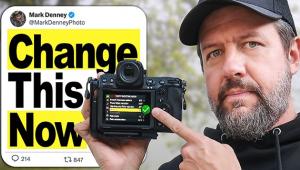Format Wars
Which One Is Right For You
Like many photographers, my first "serious" camera was a 35mm SLR. And while my original rationale for choosing it (portability, number of exposures, large selection of lenses and accessories) proved sound, it wasn't long before I discovered that 35mm's aspect ratio (height-to-width relationship of the film's image area) frequently didn't fit my way of seeing. I eventually gravitated to other formats more suited to my particular compositional peculiarities, though 35mm remains a viable tool for me, especially for slides. |
|||
But my first real recognition of camera/film format as a significant issue occurred several years ago while I was attending a photographic workshop in the Four Corners area of the Southwest. It was open to all camera formats, with just about everything between 35mm and 4x5" represented, and the presentation level was targeted at novice and intermediate photographers. At least half the attendees were new to "serious" photography, as evidenced by the heady scent of virgin cameras and the rustle of new photographer's vests. |
|||
As the workshop progressed, I had the opportunity to observe (I was covering the class for a magazine article) several novices trying to apply the instructor's lecture on the principles of seeing and composition within the constraints of their new camera's unfamiliar format shape. Some did fine, having either done their homework or just lucking out, with their camera format suiting their natural way of perceiving image composition. Others didn't fare as well, trying to fit a rectangular composition onto a square ground glass, or vice versa. Having been told to fill the frame, they were somewhat thrown for a loop when confronted with waste space at the top and/or bottom of the image, or at the sides. The workshop leader held the view that anything more than minimal cropping in the enlarger was the result of a poorly seen image to begin with, not to mention foregoing the negative's full quality potential, and encouraged the students to fully explore a subject in relation to their particular camera format shape. Most eventually showed signs of getting the hang of it, but for a few, a disproportionately large percentage of their compositional attempts were a disconcerting struggle. They, for the most part, could visualize an image in their heads, but this mental image, like as not, didn't translate successfully in the viewfinder. When the instructor encountered students having this problem, he suggested they take a look through cameras of different formats. This experience often proved enlightening, resulting in "Oohs" and "Aahs" and "Gee, I like this one!" Most, it turned out, had purchased their cameras on the advice of a sales clerk, the hype of an ad, or on the basis of a magazine review. While the latter is generally the most reliable, reviews basically let you know if the camera works as advertised, and point out the neat bells and whistles; they can't tell you whether or not the camera and format are a good match for your mental imaging processes. |
|||
Do Bigger Negs Make For Better Pictures by Frances E. Schultz In 35mm, if you want real quality, color negative is the poor relation. The manufacturers spend millions of dollars, maybe billions, and the films get better and better all the time. Better color, latitude, grain, sharpness: everything gets better. The only trouble is, they are designed mainly for the consumer market, where 4x6" prints can still be sold as "extra-size" and 5x7" is bigger than 99.99 percent of the pictures ever made. Many people have had the sad experience of trying to make a bigger print of a picture that looks really wonderful at 4x6", only to find that it "falls apart" with mealy grain and poor sharpness at a mere 8x10" enlargement. That's why professionals and serious amateurs tend to think of color negative as suitable only for snapshots and color reportage, where newspaper repro disguises all shortcomings. My advice? Move up to medium format, and everything changes completely. The Medium Format Switch Why do bigger negatives give you a print advantage? They do not have to be enlarged as much for a given print size, and even at 11x14", quality from my 6x9cm negatives is wonderful. That's just over a 4x enlargement: a bit less than a 5x7" print off 35mm, and we all know how good they can look. It becomes clear that in medium format color negative can stop being the poor relation and become the millionaire uncle. These days I use 6x9cm almost exclusively, for three reasons. The first is historical accident: the first medium format camera I ever used was a Linhof, and the 6x9cm back on my Alpa is Linhof-based. The second is that I really do like the 2:3 proportions of the 56x 84mm negative. The third is that while I also use 6x8cm (Mamiya-based 56x75mm) and 6x7cm (Linhof-based 56x72mm), I can always crop 6x9cm to these formats: gluing bits on the end of the smaller formats is less easy. My husband Roger Hicks uses 44x66mm on his Alpa, but in color, for ultimate quality, this format cannot really stand to go bigger than about 7x10" (4x) or at most 9x13" (5x). It is the film that sets the limits, not the camera or the Biogon lens. Big Negs And Scanners I make my "contact prints" from rollfilm negs this way, scanning at 600x600dpi and making my "contacts" or "ref prints" at 2x or 3x enlargements. They are not as high quality as wet proofs, but they are quicker and cheaper. Then I make real prints. I don't know why it should be, but I find it much easier to analyze big negatives on the enlarger baseboard with my Colorstar or my Jobo Colorline 100. Logically, it shouldn't matter-an 8x10 is an 8x10, whether it's blown up 7x from 35mm or 3x from 6x9cm-but it does. Perhaps I am forming my opinions more from the actual negative, before I load it into the carrier, than I realize. There is no doubt that the big negative is easier to see and to "read." The Right Combo Old Negatives Manufacturers/Distributors |




































